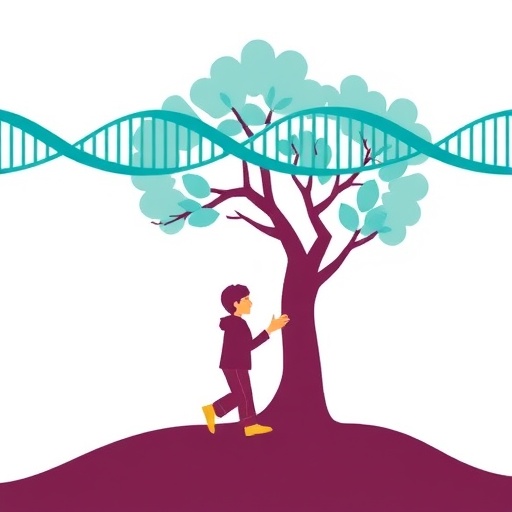In recent years, researchers have made significant strides in understanding the complex interactions between genetic variants and environmental factors that contribute to disorders of sex development (DSD). A groundbreaking study led by Qigen et al. has shed light on how specific genetic mutations and environmental toxicants work together to disrupt normal steroidogenic gene expression, offering new insights that could transform our approach to these conditions. This research highlights the intricacies of endocrine function and raises important questions about the influences that shape human development.
The study specifically investigates the impact of the genetic variant known as Lhcgr^W495X/+ in conjunction with the environmental endocrine disruptor, di(2-ethylhexyl) phthalate (DEHP). The Lhcgr gene encodes the luteinizing hormone/choriogonadotropin receptor, which plays a pivotal role in the reproductive system. By examining how this genetic variant interacts with DEHP, the researchers aimed to understand the pathways leading to DSD.
Through meticulous experimentation, the researchers discovered that the presence of the Lhcgr^W495X/+ variant alters the response of steroidogenic genes to hormonal signals. Steroidogenesis is crucial in regulating the production of sex hormones, and any disruption in this process can lead to a range of developmental anomalies. The study emphasizes that it is not solely the genetic makeup that influences development, but also the external compounds we are exposed to, which can exacerbate genetic predispositions.
In their analysis, the authors conducted various assays to assess steroidogenic gene expression levels in cellular models, revealing significant dysregulation in the presence of DEHP. The toxicant is known for its ability to mimic hormones and interfere with endocrine functions. The findings underscore the dual threat posed by genetic predispositions combined with environmental toxins, which may collectively predispose individuals to DSD.
One of the study’s critical aspects involves the mechanism by which DEHP interacts with the genetic variant, explaining how such interactions lead to altered gene expression and result in compromised reproductive outcomes. The data suggest that DEHP may enhance the detrimental effects of the Lhcgr variant, providing a molecular basis for the observed clinical phenotypes associated with DSD.
This research holds profound implications for public health, particularly in understanding how environmental chemicals influence reproductive health. As industrial compounds such as DEHP are prevalent in numerous consumer products, this study calls for a reevaluation of regulatory standards surrounding exposure to endocrine disruptors. Awareness of how genetic factors interact with environmental toxins can guide policymakers in implementing measures to mitigate risks arising from such exposures.
Moreover, the study raises critical concerns regarding the use of DEHP in manufacturing and its pervasive presence in everyday items, such as plastics and personal care products. Given that exposure begins in utero, the implications for maternal health and fetal development are particularly alarming. The findings suggest a pressing need for more stringent controls on harmful substances, particularly in products aimed at women of childbearing age.
As the research community grapples with the implications of these findings, it also opens new avenues for potential therapeutic interventions. By better understanding the interactions among genetic variants and environmental factors, researchers can potentially develop targeted therapies that address the underlying mechanisms contributing to DSD. This could lead to more effective management strategies for affected individuals and enhanced outcomes in both clinical and reproductive health.
With a growing body of literature supporting the link between environmental exposures and reproductive disorders, this study of Lhcgr^W495X/+ and DEHP stands out as a pivotal contribution to the field. By integrating genetic research with environmental toxicology, the authors have paved the way for interdisciplinary approaches to tackle the complex challenges posed by DSD. Future studies will undoubtedly build upon these foundations, further elucidating the dynamic interactions between our genes and our environment.
In conclusion, the groundbreaking work of Qigen et al. draws attention to the urgent, multidimensional challenges posed by environmental toxicants and genetic predisposition in the context of sex development disorders. Their findings not only enrich the scientific understanding of these interactions but also highlight the importance of addressing environmental health to promote reproductive wellness. As society continues to grapple with the repercussions of chemical exposures, this research serves as a clarion call to prioritize protective measures that safeguard the future of reproductive health for generations to come.
This investigation exemplifies the importance of integrating genetic insights with environmental observations, reflecting the complexity of biological systems in health and disease. It underscores the seriousness of considering both hereditary and environmental aspects during research, intervention strategies, and public health policy-making. The study’s revelations may catalyze a broader transformation in how we view and manage reproductive health, making it a landmark contribution to the discourse on genetic and environmental interactions in human development.
Subject of Research: Genetic variants and environmental toxicants in disorders of sex development.
Article Title: Genetic variants (Lhcgr^W495X/+) and environmental toxicants (DEHP) synergistically induce DSD by interfering with steroidogenic gene expression.
Article References:
Qigen, X., Kai, X., Haiming, C. et al. Genetic variants (LhcgrW495X/+) and environmental toxicants (DEHP) synergistically induce DSD by interfering with steroidogenic gene expression. Biol Sex Differ 16, 70 (2025). https://doi.org/10.1186/s13293-025-00753-0
Image Credits: AI Generated
DOI: 10.1186/s13293-025-00753-0
Keywords: genetic variants, environmental toxicants, disorders of sex development, steroidogenic gene expression, endocrine disruptors.




